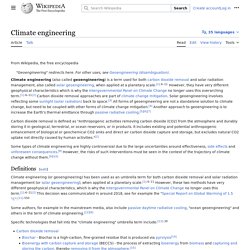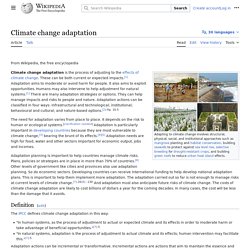

Geoengineering: A Horrible Idea We Might Have to Do. (3) Les apprentis sorciers du climat. Une étude publiée dans « Nature » montre les dangers de la géo-ingénierie solaire (...) Geoengineer the Planet? More Scientists Now Say It Must Be an Option. Once seen as spooky sci-fi, geoengineering to halt runaway climate change is now being looked at with growing urgency.

A spate of dire scientific warnings that the world community can no longer delay major cuts in carbon emissions, coupled with a recent surge in atmospheric concentrations of CO2, has left a growing number of scientists saying that it’s time to give the controversial technologies a serious look. “Time is no longer on our side,” one geoengineering advocate, former British government chief scientist David King, told a conference last fall.
“What we do over the next 10 years will determine the future of humanity for the next 10,000 years.” King helped secure the Paris Climate Agreement in 2015, but he no longer believes cutting planet-warming emissions is enough to stave off disaster. He is in the process of establishing a Center for Climate Repair at Cambridge University. Geoengineering: it could be a money-making opportunity for business. The CIA was one of the funders behind yesterday’s National Research Council (NRC) reports on geoengineering, or so the rumours have it.

If the intelligence community feels it is important to learn more about “climate intervention”, might not the same be true for the business community? In other words, is there money to be made here? The NRC, the major body in the US providing scientific and technical information to policymakers, released two reports. They show two very different approaches to reducing climate change from greenhouse gases: carbon dioxide (CO2) removal and albedo modification. Removing carbon dioxide. We can control climate, but should we? The ethics of geoengineering. Switzerland puts geoengineering governance on UN agenda. No longer the preserve of science fiction, climate-hacking technologies may need international oversight, say backers of draft resolution.

EURACTIV’s media partner Climate Home News reports. Switzerland wants the world to talk about if and how to use untested technology that tampers with nature to slow climate change – and will ask the UN’s environment arm to take the lead. Geoengineering techniques that reflect away sun rays and suck carbon from the atmosphere have long been talked about as last-resort solutions to stem the worst effects of climate change. But as greenhouse gas emissions remain stubbornly high and geoengineering research gets underway, there is growing concern these technologies could be deployed without protections against their serious risks – and that the prospect of a technofix will be taken as a licence to keep on polluting. Climate engineering. Deliberate and large-scale intervention in the Earth’s climate system We ask you, humbly: don't scroll away.

Hi, reader in Canada, it seems you use Wikipedia a lot; that's great! Explainer: Six ideas to limit global warming with solar geoengineering. Scientists agree that cutting global greenhouse emissions as soon as possible will be key to tackling global warming.

But, with global emissions still on the rise, some researchers are now calling for more research into measures that could be taken alongside emissions cuts, including – controversially – the use of “solar geoengineering” technologies. Solar geoengineering is a term used to describe a group of hypothetical technologies that could, in theory, counteract temperature rise by reflecting more sunlight away from the Earth’s surface. What is Geoengineering and Can It Save the Planet. La Capture et Séquestration de Carbone pour réduire nos émissions de CO2 - CARBONE#4. The pros and cons of geoengineering. Untitled. Climate change mitigation. Actions to limit the magnitude of climate change and its impact on human activities Coal, oil, and natural gas remain the primary global energy sources even as renewables have begun rapidly increasing.[1]

Mitigation and adaptation to climate change. En cumplimiento del Reglamento UE 2016/679 de Protección de Datos y demás normativa vigente en materia de Protección de Datos, se le informa de que sus datos de carácter personal serán tratados por Acciona, S.A.

(en adelante, ACCIONA), con los siguientes datos identificativos NIF: A08001851, Dirección: Avenida de Europa, 18, Parque empresarial de la Moraleja, 28108 de Alcobendas (Madrid), Tel: +34 91 663 28 50, email: protecciondedatos@acciona.com, con la finalidad de atender sus comentarios y gestionar sus consultas, solicitudes, reclamaciones o sugerencias, así como el envío, por medios electrónicos, de información sobre nuestros servicios y productos, a través del correo electrónico de contacto. La base jurídica para el tratamiento de los datos es el consentimiento del usuario al comunicarse con nosotros. Los datos se conservarán mientras se mantenga la relación y no se solicite su supresión y, en cualquier caso, nunca durante un plazo superior a doce meses.
L’atténuation et l’adaptation. Explaining Climate Facts - 3/3 - Adaptation & Mitigation. All about Climate Change Mitigation and Adaptation - Iberdrola. Global temperature records are being continually broken.

If last July was the hottest month in history, according to the World Meteorological Organisation (WMO), the five-year period 2015-2019 is about to become the hottest of all time. Scientists say that this type of phenomenon is becoming more probable and more persistent, and this is partly down to climate change. Climate change is a reality that is affecting millions of people across the world, especially the most vulnerable, by increasing the frequency and virulence of the extreme meteorological phenomena that cause material damage and population displacement. One only has to look back as recently as 2018, when natural disasters led to the internal displacement (ie migration within the same country) of 17.2 million people, according to the Internal Displacement Monitoring Centre (IDMC). Global warming is also the cause of the greatest environmental crisis in history, due to the unprecedented speed with which it has unfolded.
Climate Change Adaptation vs. Mitigation. 1131 learnernotes1131. Climate change adaptation. Diagram explaining the relationships between risk, hazard mitigation, resilience, and adaptation Climate change adaptation (CCA) is a response to global warming (also known as "climate change").[1] SDG13 targets to strengthen countries' resilience and adaptive capacities to climate-related issues.[2] The Intergovernmental Panel on Climate Change (IPCC) defines adaptation as: 'the process of adjustment to actual or expected climate and its effects.

In human systems, adaptation seeks to moderate or avoid harm or exploit beneficial opportunities. In some natural systems, human intervention may facilitate adjustment to expected climate and its effects'.[3] This adjustment includes many areas such as infrastructure,[4] agriculture[5] and education. [Infographie] Adaptation au changement climatique : investir 1 800 milliards de dollars et en gagner 7 000. "Les actions d’adaptation, bien faites, font partie des investissements les plus rentables pour un pays, une ville ou entreprise.
![[Infographie] Adaptation au changement climatique : investir 1 800 milliards de dollars et en gagner 7 000](http://cdn.pearltrees.com/s/pic/th/infographie-adaptation-204350274)
" Adapter Paris au changement climatique. Adapter Paris aux conséquences du changement climatique Pourquoi s’adapter ? Le changement climatique est un phénomène global : la température moyenne à la surface de la planète va augmenter au cours du 21ème siècle. Mais ces changements sont aussi observables à l’échelle locale. Le climat que nous connaissons à Paris change, et va changer tout au long du 21ème siècle. S’il est nécessaire de réduire les émissions de gaz à effet de serre pour atténuer le réchauffement climatique, il faut aussi adapter le territoire à ses effets locaux afin de le rendre plus agréable, attractif et résilient. La France baisse ses ambitions de réduction des émissions de gaz à effet de serre. Le lundi 20 janvier, l’exécutif a révélé sa stratégie nationale bas-carbone (SNBC) révisée pour la période 2019-2023.
Le gouvernement a choisi de relever le budget carbone pour cette période, ce qui permettra à la France d’émettre plus de CO2 que prévu. Dans le détail, il passe à 422 millions de tonnes de CO2 équivalent en moyenne par an, contre 398 millions prévus initialement en 2015. Cet ajustement est prévu pour être compensé au cours du troisième budget carbone, qui couvre la période 2024-2028. How much will it cost to mitigate climate change? Atténuation du changement climatique - Lutter contre l'effet de serre.
L’énergie solaire que reçoit, et réfléchit en partie, la Terre n’est pas suffisante pour nous garantir une température moyenne supérieure à - 18C°. L’apport des 33C° supplémentaires qui rendent notre planète si propice à la vie provient de la présence dans l’atmosphère de gaz tels que par exemple, le gaz carbonique et l’ozone. 6. Comment réduire les émissions de gaz à effet de serre ? 41852436. Paris Agreement. The Paris Agreement sets out a global framework to avoid dangerous climate change by limiting global warming to well below 2°C and pursuing efforts to limit it to 1.5°C. It also aims to strengthen countries’ ability to deal with the impacts of climate change and support them in their efforts.
The Paris Agreement is the first-ever universal, legally binding global climate change agreement, adopted at the Paris climate conference (COP21) in December 2015. The EU and its Member States are among the close to 190 Parties to the Paris Agreement. The EU formally ratified the agreement on 5 October 2016, thus enabling its entry into force on 4 November 2016. For the agreement to enter into force, at least 55 countries representing at least 55% of global emissions had to deposit their instruments of ratification. Key elements The Paris Agreement is a bridge between today's policies and climate-neutrality before the end of the century.